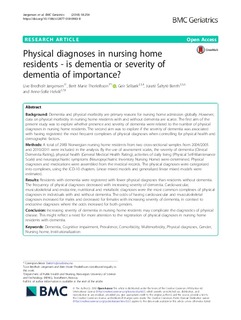| dc.contributor.author | Jørgensen, Live Bredholt | |
| dc.contributor.author | Thorleifsson, Berit Marie | |
| dc.contributor.author | Selbæk, Geir | |
| dc.contributor.author | Saltyte Benth, Jurate | |
| dc.contributor.author | Helvik, Anne-Sofie | |
| dc.date.accessioned | 2019-09-02T12:56:42Z | |
| dc.date.available | 2019-09-02T12:56:42Z | |
| dc.date.created | 2018-10-29T12:54:26Z | |
| dc.date.issued | 2018 | |
| dc.identifier.citation | BMC Geriatrics. 2018, 18 (254), . | nb_NO |
| dc.identifier.issn | 1471-2318 | |
| dc.identifier.uri | http://hdl.handle.net/11250/2612049 | |
| dc.description.abstract | Background
Dementia and physical morbidity are primary reasons for nursing home admission globally. However, data on physical morbidity in nursing home residents with and without dementia are scarce. The first aim of the present study was to explore whether presence and severity of dementia were related to the number of physical diagnoses in nursing home residents. The second aim was to explore if the severity of dementia was associated with having registered the most frequent complexes of physical diagnoses when controlling for physical health and demographic factors.
Methods
A total of 2983 Norwegian nursing home residents from two cross-sectional samples from 2004/2005 and 2010/2011 were included in the analysis. By the use of assessment scales, the severity of dementia (Clinical Dementia Rating), physical health (General Medical Health Rating), activities of daily living (Physical Self-Maintenance Scale) and neuropsychiatric symptoms (Neuropsychiatric Inventory Nursing Home) were determined. Physical diagnoses and medications were assembled from the medical records. The physical diagnoses were categorized into complexes, using the ICD-10 chapters. Linear mixed models and generalized linear mixed models were estimated.
Results
Residents with dementia were registered with fewer physical diagnoses than residents without dementia. The frequency of physical diagnoses decreased with increasing severity of dementia. Cardiovascular, musculoskeletal and endocrine, nutritional and metabolic diagnoses were the most common complexes of physical diagnoses in individuals with and without dementia. The odds of having cardiovascular and musculoskeletal diagnoses increased for males and decreased for females with increasing severity of dementia, in contrast to endocrine diagnoses where the odds increased for both genders.
Conclusion
Increasing severity of dementia in nursing home residents may complicate the diagnostics of physical disease. This might reflect a need for more attention to the registration of physical diagnoses in nursing home residents with dementia. | nb_NO |
| dc.language.iso | eng | nb_NO |
| dc.publisher | BMC (part of Springer Nature) | nb_NO |
| dc.relation.uri | https://bmcgeriatr.biomedcentral.com/track/pdf/10.1186/s12877-018-0943-8 | |
| dc.rights | Navngivelse 4.0 Internasjonal | * |
| dc.rights.uri | http://creativecommons.org/licenses/by/4.0/deed.no | * |
| dc.title | Physical diagnoses in nursing home residents - is dementia or severity of dementia of importance? | nb_NO |
| dc.type | Journal article | nb_NO |
| dc.type | Peer reviewed | nb_NO |
| dc.description.version | publishedVersion | nb_NO |
| dc.source.pagenumber | 14 | nb_NO |
| dc.source.volume | 18 | nb_NO |
| dc.source.journal | BMC Geriatrics | nb_NO |
| dc.source.issue | 254 | nb_NO |
| dc.identifier.doi | 10.1186/s12877-018-0943-8 | |
| dc.identifier.cristin | 1624461 | |
| dc.description.localcode | This article is distributed under the terms of the Creative Commons Attribution 4.0 International License (http://creativecommons.org/licenses/by/4.0/) | nb_NO |
| cristin.unitcode | 194,65,20,0 | |
| cristin.unitcode | 1920,11,0,0 | |
| cristin.unitname | Institutt for samfunnsmedisin og sykepleie | |
| cristin.unitname | Klinikk for ØNH, kjeve- og øyesykdommer | |
| cristin.ispublished | true | |
| cristin.fulltext | original | |
| cristin.qualitycode | 1 | |

